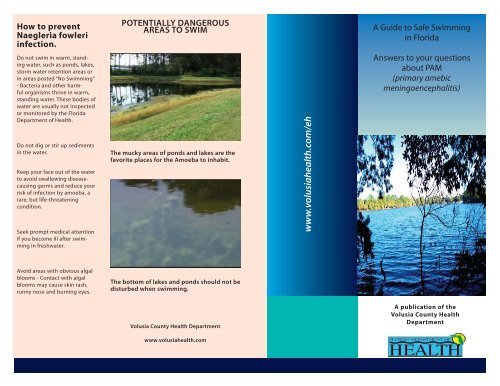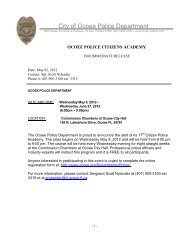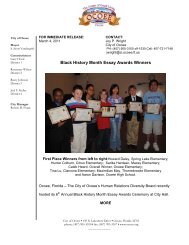Amoeba, Ponds & Retention
Amoeba, Ponds & Retention
Amoeba, Ponds & Retention
Create successful ePaper yourself
Turn your PDF publications into a flip-book with our unique Google optimized e-Paper software.
How to preventNaegleria fowleriinfection.POTENTIALLY DANGEROUSAREAS TO SWIMA Guide to Safe Swimmingin FloridaDo not swim in warm, standingwater, such as ponds, lakes,storm water retention areas orin areas posted “No Swimming”- Bacteria and other harmfulorganisms thrive in warm,standing water. These bodies ofwater are usually not inspectedor monitored by the FloridaDepartment of Health.Do not dig or stir up sedimentsin the water.Keep your face out of the waterto avoid swallowing diseasecausinggerms and reduce yourrisk of infection by amoeba, arare, but life-threateningcondition.Seek prompt medical attentionif you become ill after swimmingin freshwater.The mucky areas of ponds and lakes are thefavorite places for the <strong>Amoeba</strong> to inhabit.www.volusiahealth.com/ehAnswers to your questionsabout PAM(primary amebicmeningoencephalitis)Avoid areas with obvious algalblooms - Contact with algalblooms may cause skin rash,runny nose and burning eyes.The bottom of lakes and ponds should not bedisturbed when swimming.Volusia County Health DepartmentA publication of theVolusia County HealthDepartmentwww.volusiahealth.com
The Facts about PAM - Frequently asked questionsBlue Springs State Park, DeLand, Florida, is agreat place to swim. This spring is regulatedby the Florida Department of Health.What is Naegleria?Naegleria is an amoebacommonly found in theenvironment, in water andsoil. Only one species ofNaegleria has been foundto infect humans, Naegleriafowleri.Where is Naegleriafound?Naegleria fowleri is foundworldwide. Most commonly,the amoeba is found in· Warm bodies of freshwater, such as lakes,rivers, and hot springs· Warm water dischargefrom industrial plants· Under-chlorinatedswimming pools· SoilHow common isNaegleria infection?Although Naegleria iscommonly found in theenvironment, infectionoccurs rarely.Only 24 infections weredocumented in the U.S.between 1989 and 2000.When is Naegleriamost common?Infection with Naegleria ismost common during thesummer months, whenthe water temperature iswarm.How does infectionwith Naegleria occur?Infection with Naegleriaoccurs when the amoebaenters the body throughthe nose while the personis swimming underwater ordiving. The amoeba thentravels to the brain andspinal cord. Avoid stirringup the sediment and placingthe head underwater.Can infection bespread from person toperson?No. Naegleria infectioncannot be spread fromperson to person contact.How can I prevent aninfection withNaegleria?· Do not swim in freshwater areas that are nothealth departmentapproved bathing places· Avoid swimming inthermally polluted water(water around powerplants)· Hold the nose shutwhen jumping or divinginto bodies of freshwaterIs there treatment forinfection withNaegleria?Several drugs are effectiveagainst Naegleriain the laboratory. However,although a varietyof treatments have beenused to treat infectedpersons, their effectivenessis unclear since mostinfections have still beenfatal. Prompt diagnosis andtreatment may help.What are the signs andsymptoms of Naegleriainfection?Infection with Naegleriacauses the disease primaryamebic meningoencephalitis(PAM), a brain inflammation,which leads to thedestruction of brain tissue.Initial signs and symptomsof PAM include headache,fever, nausea, vomiting,and stiff neck.As the amoeba causesmore extensive destructionof brain tissue this leads toconfusion, lack of attentionto people and surroundings,loss of balance andbodily control, seizures,hallucinations. The diseaseprogresses rapidly andinfection usually results indeath within 3 to 7 days.Can I get Naegleriainfection from aswimming pool?No. You cannot get Naegleriainfection from a swimmingpool as long as thepool is properly cleaned,maintained, and chlorinated.For more informationplease visit the following web sites:www.volusiahealth.com/ehhttp://www.cdc.gov/ncidod/dpd/parasites/naegleria/factsht_naegleria.htm






